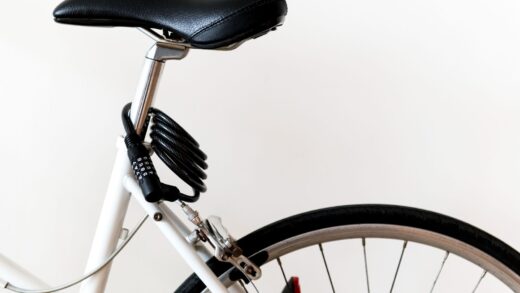Do you consider yourself a dedicated bicycle aficionado? If that’s the case, then surely you grasp the exhilaration associated with harmonizing diverse elements of a bicycle. Among these intricate pieces, the art of combining forks and frames claims a position of profound importance.
Even in cases where the dimensions of the fork and frame don’t align perfectly, they can still be united. For instance, it’s not uncommon to experiment with fitting 27.5-inch forks onto frames designed for 26-inch wheels.
Hence, the question emerges: can a 27.5 fork truly find a place upon a 26-inch frame?
Indeed, the fusion of a 27.5 fork with a 26 frame is indeed feasible! Nevertheless, this amalgamation won’t drastically alter your cycling encounter. This fusion carries with it a variety of advantages and disadvantages. On one hand, you’ll relish enhanced speed and command over your ride. However, be prepared to relinquish some of the bicycle’s visual harmony, and navigating tight turns may prove to be a challenge.
Before embarking on this venture of experimentation, there exists a trove of information to acquaint yourself with. To facilitate your journey, I’ve meticulously outlined all the merits and demerits in comprehensive detail right here.
So, let’s dive right in!
Understanding the Compatibility of 27.5 Forks with 26 Frames
The world of bicycles is both intricate and fascinating. Choices, from the type of frame to the size of the wheels, can make a substantial difference in your cycling experience. One such choice often debated is the pairing of different fork and frame sizes. For those delving into this realm, here’s a detailed look at whether you can fit a 27.5 fork onto a 26 frame.
Bicycle Forks and Frames: Does Size Always Matter?
- The Common Perception: Traditionally, many cyclists believed that the size of the frame and the fork must always match. This stems from a simplistic understanding of bike mechanics and design;
- A New Perspective: Others argue that mismatching sizes can not only work but may even be beneficial in some circumstances. Such unconventional pairings can lead to unique riding experiences and might suit specific needs.
Experimenting with Different Pairings
Indeed, adventurous riders have tried coupling a 26″ frame with 27.5″ wheels and even a 29″ fork. The key takeaway here is:
Flexibility is Key: Not every combination might feel right or serve the intended purpose, but there’s no harm in trying out and finding the optimal setup.
The Feasibility of Using a 27.5 Fork on a 26 Frame
- The Verdict: It is possible to pair a 27.5 fork with a 26 frame. Such a setup might elevate the axle crown by approximately 13mm, which may alter the ride feel and require some adaptation;
- The Bicycle Frame’s Role: The frame is the backbone of the bicycle, ensuring every part stays in its rightful place. Any change to the frame could necessitate a series of other upgrades, making it a significant decision;
- Considering Upgrades: If you’re only looking to upgrade the fork, switching the entire frame can be cost-prohibitive, regardless of whether you’re enhancing a standard or mountain bike.
Delving into Wheel and Fork Compatibility
A frequently posed query is the compatibility of a 26 wheel with a 27.5 fork. Here’s a breakdown:
The Importance of Brakes: If the bike has disc brakes, mounting a 26-inch wheel on a 27.5 fork isn’t a problem. The calipers will still align appropriately, ensuring a safe braking mechanism. However, with rim brakes, this setup won’t work because the calipers won’t align correctly with the rim.
Prospective Implications of Mismatching Forks and Frames
Now that it’s clear that a 27.5 fork can be used with a 26 frame, it’s essential to delve into the potential ramifications of this choice. Riders should be well-informed of any changes to handling, comfort, and safety before deciding on such a pairing.
Exploring the Fusion: 27.5 Fork on a 26 Frame
The world of cycling is filled with limitless possibilities, pushing the boundaries of innovation and design. One such instance is the choice to mount a 27.5 fork onto a 26 frame. But does this combination offer any tangible benefits? Are there downsides? And is it a pairing reserved solely for this specific size difference? Dive into a detailed analysis below:
Broadening the Horizon
It’s essential to understand that experimenting with different fork and frame sizes is not exclusive to the 27.5 and 26 combinations. Cyclists might be tempted to fit a 29 fork on a 27.5 frame or even a 29 fork on a 26 frame. The dynamics and outcomes might be consistent across these pairings, but here’s a focused look at what happens with the 27.5 fork on a 26 frame:
Advantages:
Enhanced Control:
- Stability at High Speeds: The heightened front end due to the larger fork improves the bike’s ergonomics, providing riders with increased space and control, especially at elevated speeds;
- Weight Distribution: The 27.5 fork introduces added weight to the bike’s front end, ensuring enhanced stability and handling.
Swift Acceleration:
- Weight Shift: With the back-end being relatively lower, the bike’s weight leans towards the rear, enabling the front wheel to spin effortlessly and thereby accelerating more quickly.
Superior Balance:
- Width Advantage: A 26-inch rim typically has a broader base. This width results in an improved balance, making wider bikes preferable to many cyclists when stability is a priority.
Drawbacks:
Aesthetic Concerns:
- The visual symmetry of the bike might be compromised. A larger fork can make the front end appear disproportionately elevated, which may not appeal to everyone.
Turn Handling:
- Elevation Challenges: The higher front end can impede the bike’s ability to navigate sharp turns, especially at higher speeds. It’s advisable to decelerate when approaching tighter turns.
Axle Crown Disparity:
- The elevation brought about by using a 27.5 fork on a 26 frame can raise the axle crown by approximately 13mm. This difference, while noticeable, can be acclimated to over time.
Braking Dynamics:
- Suspension Sensitivity: Longer suspensions tend to be more reactive to braking forces. In this pairing, the fork may respond aggressively during hard braking, potentially leading to dangerous situations;
- Geometry Impact: The increased height can change the bike’s slacking angle, directly influencing braking dynamics;
- Potential Maintenance Issues: For mountain bikes (MTBs), this configuration may result in fork oil leaks during intense braking sessions;
- Recommendation: It’s crucial to adapt braking techniques when using this setup, opting for gradual deceleration rather than abrupt stops.
Exploring the Choice: Upgrading to a 27.5 Fork on a 26-Inch Frame for Your Bicycle
Contemplating the prospect of fitting a 27.5 fork onto a 26-inch frame triggers a question of discerning priorities. Should your aim be anchored in cultivating a more laid-back angle for your bike, thereby engendering heightened mastery during rapid velocities, the inclination toward such an alteration becomes enticingly plausible. In fact, this alteration could emerge as an optimal recourse to meet your aspirations.

Nonetheless, perhaps your inclinations veer toward preserving the visual coherence of your bicycle’s exterior or circumventing the trodden path delineated by conventional bicycle precepts. Should this be your stance, the idea of incorporating the aforementioned fork may not align harmoniously with your design ethos. In such an instance, adhering to the dimensional congruence between the frame and fork appears judicious.
Integrating the dimensions of 27.5-inch forks onto a 26-inch frame would invariably orchestrate a transformative shift in your bicycling encounter. It becomes a matter of personal predilection, with divergent perspectives taking root amongst aficionados. Should this alteration align with your proclivities, a felicitous outcome is achieved. Conversely, if this recalibration doesn’t strike a harmonious chord with your sensibilities, a recourse to the erstwhile arrangement remains a viable option.
Further avenues manifest in this juncture. Alongside, the pragmatic consideration of installing the suspension fork with a meticulously attuned method emerges as an avenue to preempt an array of predicaments. Hence, the significance of this maneuver should not be marginalized, occupying a pivotal niche within the discourse.
FAQ
Certainly, opting for an upgrade to your MTB fork holds significant merit. Every enhancement bestowed upon your bike’s components inevitably ushers in a remarkable upswing in performance. It’s an established fact that any investment in this direction, though involving a financial outlay, diligently contributes to a reduction in overall weight while simultaneously augmenting the inherent structural robustness. It’s notable that the genre of XC and trail forks leans towards a featherlight construct, catering to those with a penchant for swiftness and agility. Conversely, endure and trail forks pivot decidedly towards an emphasis on maximizing performance metrics.
The advantage lies in the size of the wheels. When it comes to attributes like speed and acceleration, 27.5-sized wheels outshine their 29-sized counterparts. Their compact nature, owing to a smaller radius, plays a pivotal role. This compactness translates into rapid acceleration, with the wheels swiftly gaining momentum in a remarkably brief span. On the contrary, the 29ers exhibit their prowess during extended journeys, showcasing heightened efficiency especially in the context of lengthier rides, when matched against the 27.5ers.
ndeed, an increased fork travel confers additional robustness upon the fork assembly. Over the course of usage, the fork progressively acquires augmented rigidity while also shouldering a marginally amplified load. Furthermore, the expansion in travel dimensions directly contributes to a proportional enlargement of the fork’s overall dimensions. Such inherent attributes substantially augment the fork’s utility across a multitude of scenarios. Take, for instance, the scenario of ascending sloped terrains; here, the advantages become conspicuous. Analogously, elongated handlebars play a pivotal role in heightening the bicycle’s maneuverability and command during operation.
Conclusion
Behold, we arrive at the culmination of this literary journey. With optimism, it is to be expected that a comprehensive understanding regarding the intricacies of the 27.5 fork upon a 26 frame has been attained.
Embark upon a realm of creativity for your two-wheeled companion. Should uncertainties encircle you, consider the intriguing prospect of harmonizing 26″ forks with a frame of corresponding dimensions. The realm of possibilities extends further; contemplate the fusion of a 29″ fork with your 26″ frame, a fusion both daring and audacious.
Wishing you utmost success on your path ahead!






